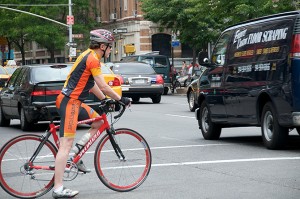Written by: Patrick Brown
Riding in and near Crosswalks: S. 144 (29) Highway Traffic Act Change – September 1, 2015
Based on a review of the old and new sections of the HTA regarding riding “within or along” a crosswalk, the following overview is provided to cyclists:
- A person can ride a bike along any crosswalk at any intersection, with or without a traffic control signal system
- A person cannot ride within a crosswalk at an intersection, with or without a traffic control signal system
- A person cannot ride within a crosswalk at a location, other than an intersection, with a traffic control signal system
- A person can ride within a crosswalk at a location, other than an intersection, without a traffic control signal system
- A traffic control system includes bicycle control signal
- A traffic control system has no less than 3 coloured lenses
Based on statutory interpretation and a review of the old section, “traffic control signal system” applies only to “a location, other than an intersection”.
Interpretation
“crosswalk” means,
(a) that part of a highway at an intersection that is included within the connections of the lateral lines of the sidewalks on opposite sides of the highway measured from the curbs or, in the absence of curbs, from the edges of the roadway, or
(b) any portion of a roadway at an intersection or elsewhere distinctly indicated for pedestrian crossing by signs or by lines or other markings on the surface
“intersection” means the area embraced within the prolongation or connection of the lateral curb lines or, if none, then of the lateral boundary lines of two or more highways that join one another at an angle, whether or not one highway crosses the other
“intersection” includes any portion of a highway indicated by markings on the surface of the roadway as a crossing place for pedestrians
“highway” includes a common and public highway, street, avenue, parkway, driveway, square, place, bridge, viaduct or trestle, any part of which is intended for or used by the general public for the passage of vehicles and includes the area between the lateral property lines thereof
“roadway” means the part of the highway that is improved, designed or ordinarily used for vehicular traffic, but does not include the shoulder, and, where a highway includes two or more separate roadways, the term “roadway” refers to any one roadway separately and not to all of the roadways collectively
“traffic control signal system” means all of the signal equipment making up the installation at any location
“traffic control signal” means that part of a traffic control signal system that consists of one set of no less than three coloured lenses, red, amber and green, mounted on a frame and commonly referred to as a signal head
New Legislation
(29) No person shall ride or operate a bicycle across a roadway within a crosswalk at an intersection or at a location, other than an intersection, which is controlled by a traffic control signal system.
Old Legislation
(29) No person shall ride a bicycle across a roadway within or along a crosswalk at an intersection or at a location other than an intersection which location is controlled by a traffic control signal system.
- Inconsistent terminology is currently used throughout the Act to describe bicycling: riding, riding on and operating are used in reference to bicycles (including power-assisted bicycles), and driving, in reference to a vehicle, also includes bicycling. A number of provisions are amended so that they consistently use “ride or operate” in reference to a bicycle or, where the bicycle in the provision does not include a power-assisted bicycle, “ride”. The usage of “drive” in reference to vehicles, which includes bicycles, is unchanged
- Subsection 144 (29) of the Act is amended to remove the prohibition against riding or operating a bicycle along a crosswalk.
Traffic Control Signal Systems
(1) Every traffic control signal shall consist of one circular amber and one circular red indication in combination with,
(a) a circular green indication;
(b) a circular green indication and one or more green arrow indications;
(c) a circular green indication, one or more green arrow indications and one or more amber arrow indications; or
(d) one or more green arrow indications.
(2) Green arrow, amber arrow, circular green, circular amber, circular red and white vertical bar indications may be used for traffic control signals and, where they are used, they shall be arranged vertically from the bottom, as follows:
right turn green arrow, right turn amber arrow, left turn green arrow, left turn amber arrow, straight through green arrow, circular green, circular green, circular amber, circular red and white vertical bar.
(3) No traffic control signal system shall be operated so as to show more than one circular indication simultaneously on the same traffic control signal.
(4) Every traffic control signal system that is installed shall have at least two traffic control signals located on the far side of the intersection from which vehicles are approaching, at least one of which shall be located on the far right side.
(4.1) Despite subsection (4), a traffic control signal system installed at a crosswalk at an intersection for the purpose of assisting pedestrians to cross the roadway shall have,
(a) at least two traffic control signals facing the directions from which vehicles on the roadway approach the crossing; and
(b) at least one stop sign facing vehicles approaching the intersection from the other intersecting roadway.
(10) A traffic control signal system may be erected and maintained at a place other than an intersection, in which event the arrangement of the traffic control signals shall comply as nearly as possible with the provisions of subsections (4) and (5).
To learn more about bike laws in Ontario, visit Bike Law Canada:
Web: bikelaw.com/Canada
Facebook: Bike Law Canada & Bike Law Ontario
Twitter: @PatrickBrownLLB






